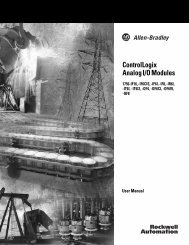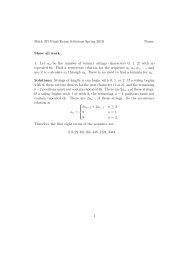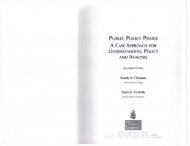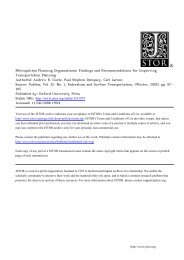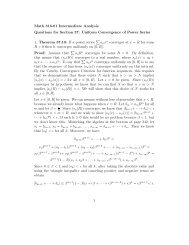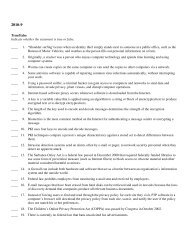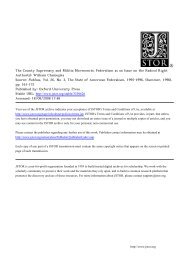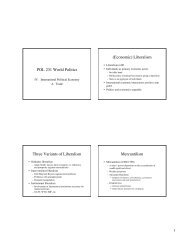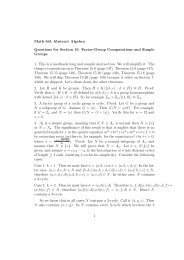Distinguished Faculty Scholar - MavDISK - Minnesota State ...
Distinguished Faculty Scholar - MavDISK - Minnesota State ...
Distinguished Faculty Scholar - MavDISK - Minnesota State ...
You also want an ePaper? Increase the reach of your titles
YUMPU automatically turns print PDFs into web optimized ePapers that Google loves.
o8<br />
fall<br />
volume 2 issue 3<br />
Discovery | creativity and innovation on campus<br />
frontiers<br />
Music professor<br />
David Dickau was<br />
one of three <strong>Minnesota</strong><br />
<strong>State</strong> Mankato faculty members<br />
to receive the <strong>Distinguished</strong><br />
<strong>Faculty</strong> <strong>Scholar</strong> Award in spring<br />
2008. He joins Suzanne Bunkers<br />
and James Robertson as the<br />
University’s first recipients of the<br />
annual award.
Art professor Matthew Willemsen explores issues<br />
related to branding. His current body of work<br />
considers how brand characteristics create notions<br />
of value for products, services, and even individuals.<br />
The detail is from a series of prints entitled “<br />
Multiple Impulses”.<br />
College of Graduate Studies and Research<br />
Dr. Anne Blackhurst<br />
Dean of Graduate Studies and Research<br />
Graduate Studies<br />
Chris Mickle<br />
Director of Graduate Programs<br />
Research and Sponsored Programs (RASP)<br />
Michelle Carter<br />
Interim Director<br />
Center for Excellence in <strong>Scholar</strong>ship and Research<br />
(CESR)<br />
Dr. Steve Bohnenblust<br />
Director<br />
McNair Achievement Program (MAP)<br />
Laura Bartolo<br />
Interim Director<br />
Undergraduate Research Conference (URC)<br />
Dr. Trent Vorlicek<br />
Dr. Gina Wenger<br />
Co-Chairs<br />
Institutional Review Board (IRB)<br />
Dr. Trish Hargrove<br />
IRB Coordinator<br />
Dr. Mary Hadley<br />
Dr. Annelies Hagemeister<br />
Co-Chairs<br />
frontiers<br />
Fall 2008 Volume 2, Issue 3<br />
Designer<br />
Kristin Higginbotham<br />
Photographer<br />
Bridget Fowler<br />
Quality 1-hr. Foto<br />
Writer<br />
Kelcey Woods-Nord<br />
David Chapman<br />
Print Coordinator<br />
Doug Fenske<br />
The mission of FRONTIERS is to celebrate the<br />
scholarly and creative accomplishments of <strong>Minnesota</strong><br />
<strong>State</strong> Mankato faculty and students and inform the<br />
campus community of research-related opportunities.<br />
FRONTIERS is published three times per year by<br />
the College of Graduate Studies and Research and<br />
distributed to <strong>Minnesota</strong> <strong>State</strong> Mankato faculty, staff,<br />
and graduate students. The College of Graduate<br />
Studies and Research welcomes ideas for feature stories<br />
and other content consistent with the mission of the<br />
newsletter. Please e-mail story ideas to cesr@mnsu.edu.<br />
Got<br />
Photos?<br />
<strong>Faculty</strong> who have high-quality<br />
digital photographs of recent<br />
research or creative projects are<br />
encouraged to submit them to<br />
the College of Graduate Studies<br />
and Research for inclusion in<br />
upcoming issues of FRONTIERS<br />
or TOMORROW. Photographs<br />
should be at least 200 dpi and<br />
should be accompanied by a brief<br />
caption describing the project and<br />
the photo. E-mail photographs (in<br />
jpg or tif format) to<br />
anne.blackhurst@mnsu.edu.<br />
frontiers<br />
10<br />
7<br />
15<br />
A CelebrAtion of sCholArshiP<br />
In their combined 70 years at <strong>Minnesota</strong> <strong>State</strong> Mankato, the first<br />
three recipients of the <strong>Distinguished</strong> <strong>Faculty</strong> <strong>Scholar</strong> Award have<br />
made lasting contributions to the fields of literature, music, and<br />
criminal justice.<br />
A CoMMitMent to QUAlity<br />
With the support of grant and contract funding, students and<br />
staff in the Water Resource Center are dedicated to improving<br />
water quality in the <strong>Minnesota</strong> River Basin.<br />
the seCret lives of PlAnts<br />
Two faculty members in the College of Education conduct<br />
research that will inform teacher preparation programs and<br />
improve educational outcomes for <strong>Minnesota</strong>’s increasingly<br />
diverse student population.<br />
Un-debAtAble AMbition<br />
When Zeke Sorenson begins his master’s program in<br />
communication studies at Kansas <strong>State</strong> University,<br />
he’ll be well on his way to realizing his ambition of<br />
becoming a collegiate debate coach. Sorenson credits<br />
the McNair Achievement Program and his mentor,<br />
James Dimock, for helping him achieve his goals.<br />
dePArtMents<br />
4 Cesr<br />
7 rAsP<br />
o<br />
10 Gsr<br />
13 UrC<br />
15 MAP<br />
16 A thoUsAnd<br />
Words<br />
4<br />
fall<br />
8<br />
volume 2 issue 3
A<br />
CelebrAtion<br />
of sCholArshiP<br />
In spring 2008, the Center for<br />
Excellence in <strong>Scholar</strong>ship and<br />
Research recognized professors<br />
Suzanne Bunkers, David Dickau,<br />
and James Robertson as <strong>Minnesota</strong><br />
<strong>State</strong> Mankato’s first <strong>Distinguished</strong><br />
<strong>Faculty</strong> <strong>Scholar</strong>s. Combined, the three<br />
recipients have taught at <strong>Minnesota</strong> <strong>State</strong> Mankato<br />
for over 70 years—during which they have achieved<br />
national prominence for their scholarly and creative<br />
work.<br />
Robertson, who teaches in the Department of<br />
Sociology and Corrections, came to <strong>Minnesota</strong> <strong>State</strong><br />
Mankato in 1980 after working in a research center at<br />
the University of California, Berkeley, School of Law.<br />
“I came to this university with anything but a concrete<br />
research agenda,” says Robertson. “Diverse work and<br />
educational experiences had honed my research skills<br />
but not my interests.”<br />
When Robertson arrived, the department asked<br />
him to teach a course on correctional law. Because<br />
prisoner rights had been unheard of until the late<br />
1960s, it was a relatively new subject. Little research had<br />
been done and few publications were available at the<br />
time—which gave Robertson the perfect opportunity<br />
to make his mark. “I was lucky to get in at the ground<br />
level,” he explains. “My career evolved as the field<br />
evolved, and there were a lot of opportunities to explore<br />
areas that other scholars hadn’t yet.”<br />
Twenty-eight years later, after publishing more<br />
than fifty individually authored journal articles,<br />
Robertson is known as one of the leading figures in the<br />
field of correctional law. His articles are read regularly<br />
continued on page 6<br />
Professor of music David Dickau (far left-hand<br />
corner) conducts the 2007 Choral Invitational<br />
Concert at Saints Peter and Paul Catholic<br />
Church. As a leading choral composer, Dickau<br />
has been commissioned to write compositions<br />
enjoyed by audiences worldwide.<br />
4 fall 08 fro ntiers fall o8 fro ntiers 5
dAvid diCkAU, sUzAnne bUnkers, And JAMes robertson<br />
A CelebrAtion of sCholArshiP continued from page 4<br />
by law students and scholars and are also consulted frequently by both<br />
judges and lawyers. As a result of his work, drastic changes have been<br />
made in prisoner rights, especially with regard to prison rape. “Thanks in<br />
part to Dr. Robertson’s work in drawing public attention to this horrible<br />
problem, action is being taken by the government to address it,” states Dr.<br />
Michael B. Mushlin, a professor of law at Pace Law School.<br />
While Robertson is busy providing prisoners a voice, Bunkers is<br />
working to create a platform for a different group of unknowns: female<br />
diary authors. Currently one of a few internationally known diaries<br />
scholars, Bunkers joined <strong>Minnesota</strong> <strong>State</strong> Mankato’s English department<br />
in 1980 and immediately began creating new courses related to women’s<br />
literature and life writing.<br />
Bunkers was familiar with life writing—which consists of shorter<br />
pieces about a person’s life and relationships—as she had been writing<br />
and publishing her own personal stories while in graduate school.<br />
“My own writing led to my interest in other women’s diaries,” explains<br />
Bunkers. “I wanted to be able to study women whose lives were unknown<br />
and forgotten.”<br />
Bunkers’ initial research on unknown women’s diaries eventually<br />
led to something much deeper. She began to care about the women and<br />
their stories, and she spent a significant amount of time researching their<br />
background information, the contexts of their diaries, and the ways in<br />
which the diaries came into the public domain. “I learned that it was<br />
impossible to stay detached and objective,” says Bunkers.<br />
Her detailed research on the lives of these women has led to eight<br />
published books, including scholarly editions of previously unpublished<br />
diaries and her own creative nonfiction, In Search of Susanna—a memoir<br />
based on Bunkers’ own experiences and memories in combination with<br />
her research. “I found the research so captivating that I not only want<br />
to read about these women, but I want to write about them as well,”<br />
she says. “That’s the goal for me—to find value in these works and then<br />
communicate that value to others.”<br />
Dickau, a professor in the Department of Music and the third<br />
<strong>Distinguished</strong> <strong>Faculty</strong> <strong>Scholar</strong>, expresses a similar sentiment when<br />
speaking about his choral compositions. After an early career working<br />
with orchestras and choirs in large churches, Dickau joined the<br />
<strong>Minnesota</strong> <strong>State</strong> Mankato faculty in 1991. One of his major goals after<br />
leaving the world of church music was to take recognized poetry and set<br />
the lyrics to music for choirs. “It was something that I really wanted to<br />
do…that I desired to do,” says Dickau.<br />
In doing so, Dickau has carved himself a niche in the musical world.<br />
He’s been commissioned by local, state and national organizations,<br />
ranging from the <strong>Minnesota</strong> All-<strong>State</strong> Choir to the Charles A. Lindbergh<br />
Foundation. “I’ve been really fortunate to have had people ask me to<br />
write music for them,” he says. “I didn’t plan it as a career, but one of the<br />
greatest things about it is that it leads to a personal connection I would<br />
not have made otherwise.”<br />
For example, Dickau was commissioned by Timothy Sawyer,<br />
the Director of Choirs at Northwestern College, to write a piece to be<br />
performed by Sawyer’s choir as a musical gift for the people of Dresden,<br />
Germany. The performance was in honor of the rebuilding of their<br />
church, where thousands of innocent refugees were killed when the<br />
church was bombed near the end of World War II. Both Dickau and his<br />
wife accompanied the choir to Dresden to hear the premier of the piece<br />
and were able to speak with several survivors of the bombing following<br />
the concert. “It was a humbling and moving experience to talk with these<br />
survivors and feel like I somehow had been honored to touch history,”<br />
says Dickau.<br />
And that’s only one example. Dickau’s compositions are being<br />
used across the nation to express the thoughts and feelings of many.<br />
And although he enjoys the composing process, it is experiences like the<br />
one in Dresden that make his work worthwhile. “It really is a cathartic<br />
event,” he says. “It’s the power of the text and the music. It helps people<br />
communicate and express their innermost feelings—that’s what it’s all<br />
about.”<br />
It is clear that Robertson, Bunkers, and Dickau have distinguished<br />
themselves as outstanding scholars in their fields. While their<br />
distinguished careers have earned them national recognition and<br />
acclaim, they are grateful for the University’s recognition of their<br />
accomplishments through the <strong>Distinguished</strong> <strong>Faculty</strong> <strong>Scholar</strong>s Award. “I<br />
was happy and honored,” says Robertson, “but also very humbled because<br />
I was in such good company.”<br />
a commitment<br />
to quality<br />
MSU graduate student Matt Ribikawski<br />
(center) records data as Bill Lamoreux<br />
(right) and Carey Christensen check water<br />
clarity on Crystal Lake recently. MSU is<br />
conducting a study of excess nutrients for<br />
state pollution officials.<br />
Photo courtesy of Scott Kudelka<br />
Dr. Shannon Fisher is a busy man.<br />
As the Director of the Water Resources Center (WRC),<br />
he is responsible for the overall operation of the center,<br />
which provides research and data collection, outreach and<br />
consultation, technical assistance, and training related to<br />
the management of water resources. In addition, he is an<br />
assistant professor of biology and serves as the Executive<br />
Director for the <strong>Minnesota</strong> River Board—a board comprised<br />
of representatives from most of the 37 Southern <strong>Minnesota</strong><br />
continued on page 8<br />
6 fall 08 fro ntiers fall 08 fro ntiers 7
A CoMMitMent to QUAlity continued from page 7<br />
8 fall o8 fro ntiers<br />
Staff of the Water Resources Center, pictured<br />
from left to right, front row: Susan Carlin, Sarah<br />
Duda, Scott Kudelka, William Lamoreux, Cary<br />
Christensen. From left to right, back row: Richard<br />
Moore, Shannon Fisher, Scott Bohling, Justin<br />
Valenty, James Fett. Not pictured: Kimberly Musser,<br />
Diane Wiley, Lucas Bistodeau, Alex Cahlander-<br />
Mooers, Whitney Carleton, Michelle Hinkle, Kyle<br />
Jarcho, Jason Rhoten, Matt Ribikawskis.<br />
counties within the <strong>Minnesota</strong> River Basin who work to improve and protect the water quality within the <strong>Minnesota</strong> River Basin.<br />
With so many roles to fill, it’s hard to imagine Fisher having time to secure the grants and contracts necessary for the WRC to<br />
operate, but with the help of his team he manages to do so. In fact, during the 2008 academic year, Fisher secured 11 contracts and<br />
3 grants totaling $852,787 and earning him the Excellence in Grants and Contracts award from the Office of Research and Sponsored<br />
Programs.<br />
Despite his obvious success, Fisher is quick to admit he couldn’t do it alone. The WRC, located in Trafton Science Center, employs<br />
8 full-time staff, 4 graduate students, and up to 20 undergraduate students annually. Fisher gives ample credit to his team for the<br />
center’s accomplishments. “I might be the director, but the WRC wouldn’t survive without the staff and students we have,” he says.<br />
“They are exceptional and the reason that we have been so successful.”<br />
Clearly, the relationship is mutually beneficial. As the center takes on more projects, resulting in more revenue, a certain<br />
percentage of that revenue is allocated for student employment. Kimberly Musser, the Assistant Director of the WRC, explains that the<br />
center was originally envisioned as a place where students and staff could get involved in water quality projects across the region and<br />
actively take part in applied research. “We help students get hands-on experience working on real-world projects, explains Musser.”<br />
James Fett, a senior double major in the Ecology and Environmental Sciences programs, has been working for the WRC for almost<br />
two years and has benefitted in multiple ways. Not only has he been able to get out into the field and take water samples himself, but<br />
he has also been trained in official protocol, has conducted and presented two independent research projects, and has made several<br />
connections with potential employers. “My experience at the WRC has certainly contributed to my success so far,” he says, “and I have<br />
no doubt it will continue to do so in the future.”<br />
Preparing students for their future in the field is exactly what Fisher hopes the center will accomplish. “When I think about the<br />
WRC’s role here on campus,” says Fisher, “it really boils down to providing a bridge between academic and experiential education.”<br />
But that isn’t all the center is about. Dealing with water quality—especially in the <strong>Minnesota</strong> River Basin, which is likely the most<br />
polluted waterway in the state—requires an excitement for the job. Water quality changes are hard to implement and the impact takes<br />
time to realize, so it’s important for people working in the field to be not only patient, but passionate as well. And Fisher has just the<br />
people for the job. “It’s not just our work, it’s our life, says WRC Communications Coordinator Scott Kudelka. “It goes beyond just<br />
work—it’s paddling the rivers, fishing the rivers, protecting the future of those waters for future generations.”<br />
rAsP honors toP GrAnt And ContrACt reCiPients<br />
In April 2008, the Office of Research and Sponsored Programs (RASP) held its second annual recognition event in honor of grant and<br />
contract recipients during the preceding year. In addition to honoring all faculty and staff who received grant or contract support,<br />
RASP recognized the following outstanding achievements.<br />
excellence in<br />
grantsmanship<br />
awarD:<br />
George Corey<br />
George Corey has been an integral<br />
part of Upward Bound since he joined<br />
the program as an assistant director in<br />
1979. Since then, he has taken over as the<br />
Director of the program and ensured that<br />
the program continues to receive federal<br />
funding. He was awarded the Excellence<br />
in Grantsmanship Award after procuring<br />
$440,907.00 in grant support from the<br />
Department of Education.<br />
One of the TRIO programs, Upward<br />
Bound is designed to motivate lowincome,<br />
potential first-generation college<br />
students to graduate from high school<br />
and pursue a post-secondary degree.<br />
Upward Bound staff work with students<br />
throughout the school year, as well as<br />
during the summer, to provide them<br />
instruction and tutoring that will help<br />
them succeed both presently and in the<br />
future. “”We not only want to make them<br />
aware of opportunities, but we want them<br />
to take advantage of them on their own<br />
and continue their self-improvement,”<br />
explains Corey.<br />
excellence in<br />
contracting awarD:<br />
Bruce Jones<br />
Dr. Bruce Jones, professor of<br />
automotive engineering technology, along<br />
with professors Gary Mead and Dr. Vince<br />
Winstead, secured five contracts totaling<br />
$696,604.00 through the <strong>Minnesota</strong><br />
Center for Automotive Research.<br />
The contracts support hands-on<br />
research projects for undergraduate<br />
and graduate students and are a result<br />
of the Center’s partnerships with<br />
several government agencies, national<br />
corporations, and state research<br />
organizations.<br />
Although the Center was initially<br />
supported through competitive grants,<br />
the high-quality work done by students<br />
in the past, as well as their professional<br />
work ethic and the publication of several<br />
research papers, has created a demand<br />
for the Center’s services. “We now have<br />
several organizations that contact us<br />
for our services directly,” says Jones. As<br />
a result, RASP awarded Jones the 2008<br />
Excellence in Contracting Award.<br />
new <strong>Faculty</strong><br />
initiative awarD:<br />
Mary Regan<br />
Dr. Mary Regan, who joined the<br />
School of Nursing last fall, was awarded<br />
the New <strong>Faculty</strong> Initiative Award as a<br />
result of her efforts to secure external<br />
funding to further her extensive research<br />
agenda.<br />
“Mary came in and hit the ground<br />
running,” says interim RASP Director<br />
Michelle Carter. “She displays the tenacity<br />
of a new faculty member who fully takes<br />
advantage of the services offered by RASP<br />
and the university.”<br />
Regan’s research program, which<br />
began as a part of her dissertation in 2004,<br />
focuses on how nurses’ conceptions of the<br />
risks inherent in childbirth increase their<br />
use of technologies known to increase the<br />
utilization of caesarean sections.<br />
excellence in grants<br />
anD contracts:<br />
Shannon Fisher<br />
(See article, page 7).<br />
fall o8 fro ntiers 9
Students collect soil from local wetlands, which they<br />
will analyze for evidence that allelochemicals released<br />
by invasive plant species may have altered the soil’s<br />
microbial community—thereby creating a hostile<br />
environment for other plants.<br />
the seCret<br />
lives of<br />
PlAnts<br />
10 fall o8 fro ntiers<br />
By David Chapman<br />
We tend to think of plants as passive organisms: their seeds rely<br />
on wind and animals for dispersal, and they can’t relocate if local<br />
conditions change. The immobile nature and quiet beauty of plants<br />
trick the human brain into characterizing them as peaceful denizens of<br />
nature: the strong, protective oak tree; the delicate, alluring orchid.<br />
While these iconic depictions help us identify with the natural<br />
world, they simultaneously hinder us from thinking about the<br />
competitive struggle within the plant kingdom. When we do think<br />
about this struggle, we tend to think about plants outcompeting each<br />
other for limited resources—if one plant grows faster and blocks light<br />
from reaching other plants, it gains a competitive advantage. For many,<br />
this is not terribly exciting stuff—especially compared to a pride of<br />
lions chasing down a baby gazelle—and it goes a long way toward<br />
explaining the absence of a Plant Planet cable channel.<br />
But there is more to the world of plant competition than most of us<br />
realize. It turns out that some plants actively fight their neighbors with<br />
an arsenal of chemical weapons. Under normal circumstances, this<br />
chemical warfare results in a stalemate of sorts—some plants attack,<br />
others defend, and borders are drawn. But when the attacking plant<br />
is an invasive species, you’ve got a potentially serious problem on<br />
your hands. “Exotic species may be bringing ‘novel weapons’ from<br />
their native ranges here to North America that our native wetland<br />
plants are not adapted to and have no defense against,” says Dr.<br />
Bradley Cook, assistant professor of biology at <strong>Minnesota</strong> <strong>State</strong><br />
Mankato.<br />
Some of these “weapons” in question are known to plant<br />
biologists as allelochemicals, and they represent an exciting area of<br />
research that may force us to rethink what we know about plants<br />
and how they behave.. Cook and his student researchers have been<br />
studying competitive strategies in non-native wetland plants for four<br />
years, and their work has led to new insights into the invasive success<br />
of these species.<br />
Imagine a typical <strong>Minnesota</strong> wetland ringed with elegant,<br />
swaying cattails. This picture is a symbol of ecosystem health, right?<br />
Unfortunately, in real life, the cattail you’re most likely to see is a<br />
non-native invasive species, Typha angustifolia. And why this species<br />
Assistant professor of biology Brad Cook (third from left,<br />
in red cap) involves students in his research on invasive<br />
plant species, such as the narrow-leaf cattail.<br />
is outcompeting native wetland plants may hinge on its use of<br />
allelochemicals.<br />
When Cook and graduate student Meghann Jarchow and<br />
undergraduate Indumini Weeramantri ran a controlled study<br />
examining competition between the invasive cattail and a native<br />
species of bulrush, they found that when they ameliorated the effects<br />
of the cattail’s allelochemicals, the native bulrush was the better<br />
competitor. But when the cattail’s allelochemicals were uninhibited,<br />
the invasive cattail was the clear winner—the native species had no<br />
natural defense against the apparent barrage of chemicals that the<br />
cattail released into the soil environment. “Allelopathic effects have<br />
been observed in other cattail species but not in Typha angustifolia,”<br />
says Cook. “This has been one of the most surprising and interesting<br />
results from our research.”<br />
To help obtain these results, Cook runs a lab that emphasizes<br />
cooperation among his graduate and undergraduate researchers. “I<br />
continued on page 12<br />
fAll 08 fro ntiers 11
the seCret lives of PlAnts continued from page 11<br />
try to instill an esprit de corps in the lab among undergrads and grads<br />
alike to share what they are doing and to help each other with<br />
their research,” says Cook. “When one of us harvests an experiment,<br />
we coordinate a time when we all can work together to get it done<br />
quickly.”<br />
This sense of common purpose has helped Cook’s team<br />
produce new understanding about the secret lives of invasive<br />
plants. In addition to the cattail studies, other research in the lab, in<br />
collaboration with Dr. Tim Secott, a microbiologist, and the focus<br />
of graduate student Sean Wheelock, has discovered some evidence<br />
of an unusual mechanism used by the invasive reed canary grass.<br />
Unlike other competitive mechanisms that act directly on a plant’s<br />
nearest neighbors, reed canary grass’s chemicals appear to act instead<br />
on the microbial community in the soil. By changing the microbial<br />
community, the chemicals make the soil an inhospitable environment<br />
for other plant species. To put it bluntly, says Cook, “this is weird.”<br />
Of course, plants at war is a metaphor just as flawed as passive<br />
and peaceful plants. War and peace require will and conscious action,<br />
12 spring 08 fro ntiers<br />
and plants lack the centralized nervous system required for both. In<br />
some respects, this makes their interactions even more impressive.<br />
On a cellular level, they are hardwired to accept and respond to<br />
physical and biological cues from their environments. And though<br />
we aren’t accustomed to thinking about plants as being quick on<br />
their feet, Cook’s studies indicate that Typha angustifolia regulates its<br />
chemical mix. “This species appears to produce different amounts<br />
and types of allelochemicals, depending on what plants are its<br />
neighbors,” says Cook. “Hence, it somehow ‘senses’ what’s around it.”<br />
Cook believes that developing an understanding of these<br />
competitive strategies will eventually aid resource managers in the<br />
fight against invasive species. “We have a tendency to try to eliminate<br />
unwanted plants via the use of chemical herbicides without knowing<br />
or understanding what makes them thrive,” he says. “Without<br />
knowing or understanding the mechanism for their success, our<br />
management of these species can be ineffective, inefficient, or even<br />
facilitate their invasion.”<br />
And there’s good reason to fight the invasion. Although plant<br />
ranges have been expanding and contracting throughout time, the<br />
current spread of invasive species is occurring at an unprecedented<br />
rate. The rise of human movement on a global scale is directly<br />
responsible for this wave of plant dispersal, and the pace is too fast for<br />
native plants to adapt.<br />
Consequently, these plant dispersals are major contributors to the<br />
degradation of native biodiversity, which is a good indicator of overall<br />
ecosystem health. “Biological diversity is important, not simply<br />
because we may discover a new ‘wonder drug’ produced by some<br />
rare plant in a remote jungle somewhere, but because plant diversity<br />
plays an important role in the resiliency or stability of an ecosystem<br />
to provide food and habitat for other organisms—including humans,”<br />
says Cook.<br />
The current wave of human-caused plant dispersals is more than<br />
just an academic concern. In fact, according to a report by the Nature<br />
Conservancy, about 40% of the plants and animals on the federal<br />
threatened and endangered species list are on that list primarily<br />
because of competition with invasive species.<br />
For his part, Cook hopes to continue to identify the mechanisms<br />
that allow some non-native species to become invasive. “My hope is<br />
that our research will make management or control of these species<br />
more effective and efficient.”<br />
With 5,000 alien plant species established in U.S. ecosystems,<br />
there’s a lot of work to do.<br />
zZeke Sorenson’s passion for speech and debate is evident the<br />
moment you speak with him. His voice is dynamic as he explains how<br />
the sport has helped shape him into the person he is today. “Being<br />
active in speech and debate has helped me in so many areas of my<br />
life,” he explains. “It’s developed my critical thinking skills, impacted<br />
my educational decisions, and played a huge role in my daily life.”<br />
Originally from Washington, Sorenson attended a community<br />
college in Cheyenne, Wyoming for two years and competed on the<br />
school’s forensics team. His coaches in Cheyenne had connections<br />
to the forensics team at <strong>Minnesota</strong> <strong>State</strong> Mankato. After meeting<br />
and interacting with the team at the national tournament, Sorenson<br />
decided to transfer to <strong>Minnesota</strong> <strong>State</strong> Mankato to earn a four-year<br />
degree in Speech Communication, compete on the forensics team, and<br />
McNair<br />
focus on his aspirations of attending graduate school and becoming a<br />
collegiate forensics coach.<br />
Once on campus, Sorenson discovered an opportunity that<br />
would set him well on his way to realizing his dreams—the McNair<br />
Achievement Program. “My coaches knew I was interested in<br />
continuing my education and they knew I qualified for the program,<br />
so they encouraged me to apply,” explains Sorenson. Because he<br />
already had a clear-cut vision for his future, the McNair program<br />
simply provided Sorenson with the resources he needed to reach<br />
his goals. “Zeke was one of those students who came in with a lot of<br />
direction,” says McNair Interim Director Laura Bartolo. “He could<br />
articulate where he wanted to go and what he wanted to do. All we<br />
had to do was partner<br />
with him to get him<br />
there.”<br />
One component<br />
of that partnering<br />
role is providing scholars with faculty mentors. Sorenson chose to<br />
work with James Dimock, assistant coach of the speech team and<br />
instructor of speech communication. Dimock already knew Sorenson<br />
from class and was impressed with his work ethic, critical thinking<br />
skills, and commitment to education. However, he also knew that if<br />
Sorenson wanted to move on to a graduate program, he would need<br />
a better understanding of the unspoken rules and norms that often<br />
exist in academia. “It’s very difficult to succeed if you are unaware<br />
of or don’t understand these hidden expectations,” says Dimock. “I<br />
think that one of the purposes of McNair mentors is to help scholars<br />
navigate the unknown, which hopefully creates more options for them<br />
in the end.”<br />
Sorenson took full advantage of his mentorship with Dimock,<br />
as well as the McNair program itself. He completed an independent<br />
research project, presented his findings at multiple conferences,<br />
and visited several graduate schools—and, consequently, received<br />
competitive offers from multiple programs. “Zeke did everything<br />
we asked him to and more,” says Bartolo. “As a result, he was in the<br />
position of picking between two really attractive graduate packages.”<br />
Sorenson has decided to attend Kansas <strong>State</strong> University (KSU)<br />
in the fall where he will pursue a Master of Arts in Communication<br />
Studies and be a graduate assistant coach for the forensics team. At<br />
KSU, he’ll rely on his dedication, enthusiasm, and hard work to move<br />
one step closer to his ultimate goal of coaching collegiate forensics.<br />
“Zeke is one of the finest students to come through our program,” says<br />
Bartolo. “He is very deserving of the things he is going to achieve and<br />
the things he’s going to experience. He did it all himself.”<br />
un-debatable ambition<br />
<strong>Scholar</strong> and June 2008<br />
graduate Zeke Sorenson (left) was<br />
mentored by James Dimock, assistant<br />
coach of the speech team and<br />
instructor of speech communication.<br />
Sorenson is attending Kansas <strong>State</strong><br />
University, where he is pursuing a<br />
Master of Arts in Communication<br />
Studies and serving as a graduate<br />
assistant coach for the forensics team.<br />
fall o8 fro ntiers 13
Cassie Neiman presents her<br />
poster session, Coding of<br />
Emotions and Logic when<br />
Making Decisions, at the<br />
10th annual Undergraduate<br />
Research Conference.<br />
Neiman’s project, which<br />
was conducted under the<br />
mentorship of assistant<br />
professor of psychology Emily<br />
Stark, was one of 65 poster<br />
sessions.<br />
14 fAll 08 fro ntiers<br />
Brian Welch presents<br />
Instrumentation to Monitor<br />
Bridge Foundation on the<br />
Crosstown Project. Welch<br />
was mentored by assistant<br />
professor of mechanical and<br />
civil engineering Aaron<br />
Budge.<br />
since 1999, the Undergraduate research Conference (UrC) has showcased some of the best faculty-student collaborations<br />
on campus and provided a venue for celebrating the investigative and creative accomplishments of <strong>Minnesota</strong> state<br />
Mankato undergraduates. the tenth annual conference was no exception. A record number of students participated in the<br />
conference, which also featured a record number of poster sessions, oral presentations, exhibitions, and performances.<br />
A PerfeCt 10<br />
Brendon Watts presents<br />
Spectral Properties of a Class<br />
of Bipartite Graphs at the<br />
10th annual URC. Watts<br />
was mentored by assistant<br />
professor of mathematics<br />
and statistics In-Jae Kim.<br />
Miwako Fujikata presents<br />
her poster session, Priming<br />
the Bicultural Mind, to<br />
Dean of the College of Social<br />
and Behavioral Sciences<br />
John Alessio. Fujikata, who<br />
was mentored by associate<br />
professor of psychology Vinai<br />
Norasakkunkit, was a URC<br />
small grant recipient.<br />
fAll 08 fro ntiers 15
frontiers<br />
college of graduate studies & research<br />
minnesota state university, mankato<br />
115 alumni Foundation center<br />
mankato, mn 56001<br />
A thousand Words<br />
A table lies in wait for guests of honor at the 2008 URC luncheon, the culminating<br />
event of the two-day conference. In addition to honoring top student presentations,<br />
the luncheon featured a keynote address by Assistant Vice President of Academic<br />
Affairs Brenda Flannery.




